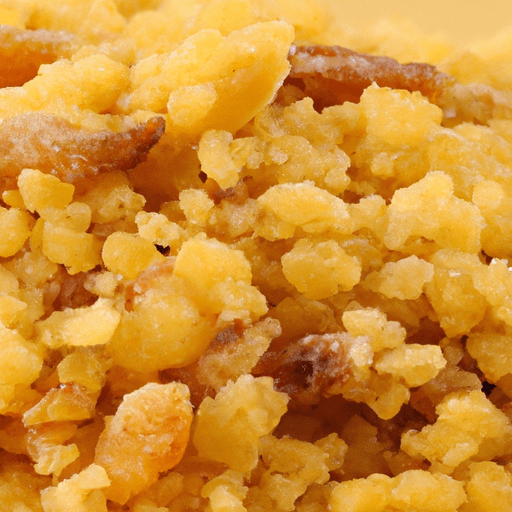Unveiling the Delightful World of Panko Breadcrumbs
Are you passionate about creating crispy, golden delights that delight the senses? Look no further - we introduce you to the wonderful world of panko breadcrumbs! Panko breadcrumbs are a culinary secret weapon that can elevate your cooking to new heights. In this blog post, we’ll dive into the captivating origins, unique characteristics, versatile uses, and nutritional benefits that make panko breadcrumbs a must-have pantry staple.
Origins and Interesting Facts
Panko breadcrumbs, originating from Japan, have gained popularity worldwide due to their exceptional qualities. Unlike standard breadcrumbs, panko is made from white bread without crusts, resulting in exceptionally light and airy flakes. The word “panko” itself is derived from the Japanese words “pan” (meaning bread) and “ko” (meaning powder). Introduced to Japan by Portuguese traders during the 16th century, panko has evolved over time and become an essential ingredient in both Japanese and international cuisines.
Texture and Taste Sensation
Panko breadcrumbs stand out with their distinct texture, which sets them apart from their traditional counterparts. With their larger and flakier pieces, they create a superior crunchy coating and add a delightful contrast to countless dishes. When cooked, panko develops a perfectly golden and crispy texture, making it an excellent choice for achieving a satisfying crunch without turning greasy. The lightness of panko ensures that it won’t weigh down your creations, allowing other flavors and ingredients to shine. As for the taste, panko breadcrumbs have a neutral flavor that doesn’t overpower dishes, allowing the seasonings and spices to take center stage.
Culinary Uses of Panko Breadcrumbs
Panko breadcrumbs are remarkably versatile and can be employed in myriad culinary creations. They are especially beloved for their incredible ability to achieve the perfect crispy coating. Whether you’re making crispy chicken tenders, fish fillets, or a dazzling vegetable tempura, panko breadcrumbs will infuse your dishes with a delightful texture that sparks joy with every bite.
Moreover, these breadcrumbs are perfect for binding ingredients in meatballs, meatloaf, and vegetarian patties, as they soak up moisture and prevent excessive shrinkage. The light and airy composition of panko also works wonders when used as a topping for gratins, macaroni and cheese, or casseroles, forming an irresistible golden crust.
Nutritional Benefits
When engaging in culinary adventures, it’s always a bonus if the ingredients we use offer some nutritional benefits. Panko breadcrumbs provide a few advantages worth mentioning. While they are not inherently nutrient-dense, panko is low in fat and calories, making it a healthier alternative to traditional breadcrumbs. By using panko instead of regular breadcrumbs, you can reduce the overall fat content of your dishes without sacrificing on flavor or texture.
Panko breadcrumbs are a phenomenal addition to any kitchen, enlivening your dishes with their distinctive texture and delicate flavor. Whether you’re creating crispy coatings, binders, or gratin toppings, panko breadcrumbs provide that satisfying crunch we all crave. With their fascinating history and versatility in the kitchen, it’s no wonder that panko has become a beloved staple - beloved in Japan and revered by cooks around the world.
So, the next time you embark on a culinary journey, don’t forget to reach for a box of panko breadcrumbs. Let them guide you toward culinary greatness, as you savor the delightful miracles they create in your own kitchen.
Origin:
Panko breadcrumbs originate from Japan. “Panko” is derived from the Japanese word “pan” meaning bread, and “ko” meaning powder or flour.
Common Uses:
Panko breadcrumbs are widely used in Japanese cuisine and have gained popularity in Western cooking as well. They are commonly used as a coating for fried or baked dishes, providing a light, crispy texture. Panko breadcrumbs are especially favored for dishes like tonkatsu (breaded and deep-fried pork cutlets) and katsu curry in Japanese cuisine. In Western cooking, they are often used to coat chicken, fish, or vegetables before frying.
Nutritional Benefits:
Panko breadcrumbs are made from bread without crusts, typically from white bread. They have a lower calorie content compared to regular breadcrumbs, and their light texture allows for less absorption of oil during cooking. However, they are not a significant source of nutrients and should be used in moderation as part of a balanced diet.
Unique Properties:
Panko breadcrumbs have a distinct texture, different from regular breadcrumbs. They are larger, coarser, and airier, which contributes to their crispy and light texture when cooked. Their unique texture makes them ideal for achieving a crunchy coating on various dishes.
Historical Significance:
Panko breadcrumbs were introduced to Japan during the late 19th century by Portuguese traders. They brought the concept of bread and breadcrumbs to Japan, which was relatively unfamiliar with these ingredients at the time. Over time, Japanese cooks adapted the technique and created their own version of breadcrumbs, resulting in the creation of panko. Today, panko breadcrumbs are widely used in both Japanese and international cuisine.




Use the share button below if you liked it.
It makes me smile, when I see it.